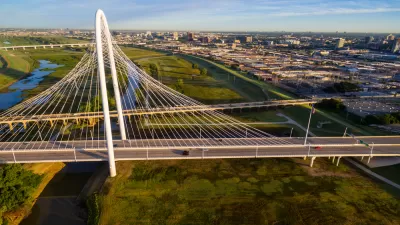A whitewater feature built into the Trinity River in Dallas will have to go—it rendered the river unnavigable and thus breached the terms granted by a U.S. Army Corps of Engineers permit.
"The Dallas City Council voted Wednesday to spend almost $2 million to partially remove the whitewater feature in the Trinity River that opened and closed in a matter of days in the spring of 2011 after the Army Corps of Engineers said it rendered the river unnavigable," reports Robert Wilonsky.
The decision effectively ends the saga that began from day one of the "Standing Wave's" existence.
The city has spent years grappling with the $4 million whitewater feature beneath the Santa Fe Trestle. The issue was never with the feature itself, which kayakers continued to use even after the city officially closed it, but the narrow bypass channels. They were supposed to offer boaters a calm alternative to the human-made rapids. But, instead, they were far more turbulent than the Wave itself.
As far as the corps was always concerned, the bypass channels rendered the river unnavigable. And that violated the permit that allowed the city to construct the Dallas Wave.
Last Planetizen checked-in with the project, the city was reacting to a failed legal effort to force the U.S. Army Corps of Engineers to change its designation of the river. Now the city has been forced into choosing the cheapest of three options: $7.4 million to completely remove the feature, $4.2 million to modify it, and $2 million to partially remove it.
FULL STORY: Dallas will spend $2 million to remove $4 million whitewater feature from Trinity River

Alabama: Trump Terminates Settlements for Black Communities Harmed By Raw Sewage
Trump deemed the landmark civil rights agreement “illegal DEI and environmental justice policy.”

Planetizen Federal Action Tracker
A weekly monitor of how Trump’s orders and actions are impacting planners and planning in America.

Why Should We Subsidize Public Transportation?
Many public transit agencies face financial stress due to rising costs, declining fare revenue, and declining subsidies. Transit advocates must provide a strong business case for increasing public transit funding.

Understanding Road Diets
An explainer from Momentum highlights the advantages of reducing vehicle lanes in favor of more bike, transit, and pedestrian infrastructure.

New California Law Regulates Warehouse Pollution
A new law tightens building and emissions regulations for large distribution warehouses to mitigate air pollution and traffic in surrounding communities.

Phoenix Announces Opening Date for Light Rail Extension
The South Central extension will connect South Phoenix to downtown and other major hubs starting on June 7.
Urban Design for Planners 1: Software Tools
This six-course series explores essential urban design concepts using open source software and equips planners with the tools they need to participate fully in the urban design process.
Planning for Universal Design
Learn the tools for implementing Universal Design in planning regulations.
Caltrans
Smith Gee Studio
Institute for Housing and Urban Development Studies (IHS)
City of Grandview
Harvard GSD Executive Education
Toledo-Lucas County Plan Commissions
Salt Lake City
NYU Wagner Graduate School of Public Service




























